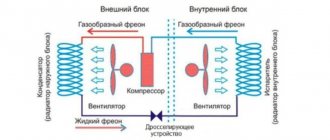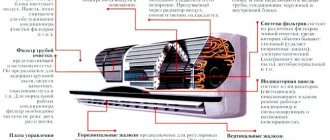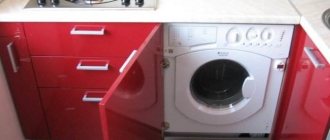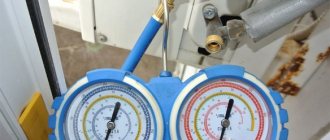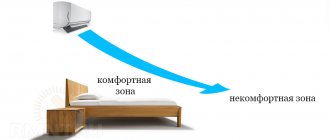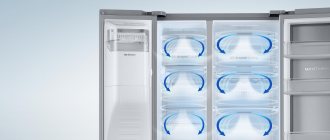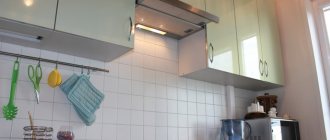Air conditioners and split systems
Devices that create a microclimate have a common name - air conditioners. Let's tell you what the difference is between air conditioners and split systems. Air conditioners can be made as a single unit or divided into indoor or outdoor units. In the first case, mobile or window air conditioners are usually used. The former can be moved indoors, but they have bulky pipes to move air. Window windows are installed in one block so that one side is located indoors and the other is located outside. They occupy part of the window opening and create noise during operation.
Split systems are divided into two blocks (compressor-condenser and evaporation), connected to each other by tubes and electrical wires. The noisiest part of the split system is located outside.
The use of such devices means fresh air and comfort Source vkrostov.ru
The difference also exists in terms of design. Window and mobile units are more bulky, and the internal parts of split systems come in a variety of shapes and colors and can often be installed on walls, floors or ceilings without disturbing the design of the room. Another difference is the possibility of not only cooling, but also heating the air.
A split system is more difficult to install. However, it offers more features and is more economical than conventional air conditioners.
Split systems are often installed in hotel rooms; what is it and what is it for? Let’s try to understand this in more detail.
Advantages and disadvantages of split systems
Let's try to analyze all the information about split systems and find out what pros and cons they may have. The entire process of installing split air conditioners can be considered an undoubted advantage. Placing an external unit does not require much space, and there is no need to seriously change the appearance of the facade. The indoor unit can be placed anywhere. Here everything depends on the available budget and imagination. At the same time, different types can be built in different rooms and spaces, for example, install a wall-mounted one in the kitchen, and a ducted one in the bedroom.
With one split system you can create comfort throughout your entire home.
Separating the noisiest block and moving it outside is a wise move. This reduces the overall noise from the air conditioner in the room. Meanwhile, the internal unit can be “stuffed” with a variety of electronics and various control and filtration systems, which is what developers use, making their devices more and more convenient and functional.
Some of the described advantages may also give rise to disadvantages. For example, division into blocks will be very frustrating if the outer part fails. After all, if several rooms were cooled at once, then all of them would be without fresh air. The same applies to the impossibility of setting certain temperatures in different rooms. If you cool the air in one, you won’t be able to heat it in the other. The above-mentioned plus in the form of ease of installation can suddenly become a rather expensive minus if you have to place the blocks at a great distance from each other.
Principle of operation
The design of a split system air conditioner is based on the fact that in cooling mode, freon takes the temperature inside the room and releases it in the outdoor unit. In heating mode, this cycle is performed in the opposite way.
The working fluid in the split system is gaseous freon. It is compressed in the compressor, simultaneously increasing the temperature. After this, the freon is transferred to the outdoor unit.
A high-quality climate system is indispensable in the home Source epicentrk.ua
There it releases the accumulated heat into the surrounding air. As a result, it lowers its temperature and begins to condense. In liquid form, freon enters the throttle and is transferred to the internal part of the system. Then it starts to evaporate.
Since the temperature is lowered, freon takes heat from the heated air in the room. Then it enters the compressor input and the operating cycle begins again.
Adjusting the operation of the split system involves changing the volume of freon used. By changing it, you can change the rate of heat transfer in the desired direction. Adjustment is carried out using a throttle valve.
When we see an air conditioner or split system, it is not difficult to understand what it is. Air conditioning is the general name for devices for creating comfortable climatic conditions. A split system is a variation of it, consisting of indoor and outdoor units and having a number of additional capabilities.
Work can occur in several modes.
Cooling
In this case, the indoor unit absorbs thermal energy indoors. Freon is discharged into the external unit, releases temperature to the surrounding space and, after cooling, enters the internal unit again.
Split systems can be used for cooling Source aeroclima.ru
The principle of operation of a split system is that when freon is compressed under the action of a compressor, it heats up and takes the temperature from the environment.
Heat
During the fall or winter months, it can get very chilly indoors. In such cases, using a split system can raise the air temperature in the room. For this, a working cycle with reverse movement of freon is used.
The gas is compressed and heated in the external unit, then transferred to the internal one. Here the freon releases temperature and cools. If such use of a split system is a priority, it is recommended to purchase systems that use heating elements. When using this operating mode, electrical energy consumption increases sharply.
The system can be used for heating Source prom.st
Air dehumidification
Split systems can remove excess moisture from the air. There will be some differences in how the split system works, depending on the selected mode. If cooling or heating of air is not required at the same time, then you can only turn on the drying mode, which does not use the freon operating cycle. Otherwise, after cooling or heating, the air drying stage will simply be added.
Circulation and cleaning
In this case, there may also be no heating or cooling of the air, but only intensive mixing and cleaning.
During operation, air is passed through cleaning filters. Both coarse and fine filters can be used, providing high quality cleaning.
The use of carbon filter elements makes it possible to clean not only dirt and dust, but also odors.
Split system purifies the air Source prom.st
Split systems - what is it?
Air conditioning is a general definition, it includes mobile, cassette, duct, column, VRV, split systems and so on. Any split system is an air conditioner, but not every air conditioner is a split system! Let's first understand what a split system is? A split system is a split air conditioner. The root of this word is the English word “split” - which means “to divide”, and more specifically, it allows you to divide, say, a window air conditioner into two parts, internal and external, so that people have the opportunity to create the required temperature in a zone anywhere in your home. buildings, premises.
To put it more simply, the window air conditioner was “sawed” into two parts and connected with tubes, which allows these “sawn” parts to be placed at a distance of up to 15 meters, or even more. This created an innovative opportunity to cool a room located in the center of the building, which was previously impossible to do. Due to the fact that the compressor-condenser part was moved outside, the noise problem was also solved, and now the air conditioners are silent.
Advantages and disadvantages
Split systems are characterized by the following advantages:
- The ability to independently, automatically, maintain the room temperature in a given range.
- The ability to create a microclimate that evokes a feeling of comfort.
The split system creates a pleasant indoor climate Source installation-air-conditioners74.rf
See also: Catalog of companies that specialize in ventilation and air conditioning.
- Compared to other types of climate control equipment, the case under consideration consumes significantly less electrical energy. Savings can reach 30%.
- Split systems operate with virtually no noise.
- They are well suited for use in subzero temperatures.
- There is a well-designed, convenient control system.
The split system is the creation of completely comfortable climatic conditions regardless of the time of year.
Such systems have a higher cost compared to air conditioners. Their disadvantage is their vulnerability to power surges. To eliminate the possibility of such situations, it is necessary to connect the split system through a voltage stabilizer.
The outdoor module on the outside of the wall slightly spoils the appearance of the building. Therefore, it is more advantageous to place it in other places (for example, on the roof or in the corridor).
External block on the facade of the building Source www.yuga.ru
Differences between a split system and an air conditioner
Compared to split systems, air conditioners are simpler designs with a minimal set of functions.
Main differences:
- Condensation from monoblock air conditioners is collected in a special container, from where it is removed manually by the user. In split systems, condensate is discharged to the street through a drainage pipe.
- The design of split systems is more attractive to buyers. This technique is presented in a variety of variations and colors, which allows a person to choose a device for harmonious integration into the interior space. The design of air conditioners is more primitive.
- Split systems operate silently; conventional air conditioners make noise when operating.
- The air conditioner does not have additional functionality that is inherent in modern split systems. For example, air purification, ionization and humidification, removal of unpleasant odors, oxygen saturation mode, air flow adjustment, motion sensor, sleep mode, etc.
And, of course, the main difference between these two types of climate control equipment is the price. Conventional air conditioners are budget equipment; split systems are more expensive, which is fully justified by the expanded functionality of the device.
How to choose an air conditioner for your home: types, parameters
Design
To operate a split system, you must have indoor and outdoor units. They are connected to each other using a drainage line through which freon is transferred.
External unit of the system
It is placed outside the room. It can be placed in different ways: on the outer wall of the house, on the roof, in the lobby of the building. At home, you can use a balcony or loggia for this.
External block Source tildacdn.com
The device contains the following components: capillary tube, compressor, condenser, four-way valve, fan and receiver. In some models, the design may additionally include an inverter control board, a compressor switching relay, a filter for an “oxygen shower,” or others.
In non-inverter split systems, the external unit is connected using a power cable. The noise from the compressor located on the outside of the wall is significantly reduced in the room.
Indoor unit
It is mounted inside the room. The following possibilities may be provided:
- Using the remote control.
- The use of filters that are used for better air purification.
- Using a timer to turn on and off at specified times.
Indoor unit Source www.office-zakaz.ru
Features of inverter split systems
Usually the device turns off when the desired temperature is reached. If necessary, the split system will turn on again. In inverter split systems such shutdowns do not occur. This is achieved by changing the frequency of the compressor by converting AC to DC.
After such a conversion, the reverse action will be performed. The result will be an alternating current with new characteristics to perform the current task. Such switching occurs smoothly, increasing the efficiency of the device.
Application of inverter systems Source nuz.uz
Due to the continuous nature of the operation, noise is reduced and energy is saved. When using some models in this mode, electricity is consumed by 39% less. Reducing noise allows you to install inverter systems in a nursery or bedroom. The absence of sudden starts and stops increases their service life.
The principle of operation of the split system
The operating principle of all cooling units is based on freon. Freon is a mixture of ethane and methane. Freon can be in liquid or gaseous form.
By turning on the cooling or heating function, the system reaches the desired temperature and then switches to fan mode. When the target is reached (depending on which mode is selected), the cooling (heating) system will turn on again. Split system is equipped with night mode. The principle is the same. The advantage is that the integrated program increases the temperature by 1 degree every 2 hours to avoid hypothermia.
In heating mode, the equipment can be used if the temperature outside the window is not lower than – 8 degrees Celsius.
Varieties
Split systems can be mounted on walls, floors and ceilings. Depending on the installation method, split systems have various features. At the same time, the operating principle of the split system air conditioner does not change.
Wall-mounted climate control devices
This type of device is the most common. They are characterized by the following:
- A compressor is used here, which provides for heating the drainage.
- The pressure device is locked.
- Braking elements are used.
- An electronic control system is used, which includes the function of maintaining a given temperature regime.
Wall-mounted system Source climatworld.com
Wall-mounted devices are usually characterized by high-quality assembly and beautiful design.
Ceiling and floor systems
They are advantageous to use in rooms that have an oblong shape. Changes in air temperature lead to the formation of air currents that carry air throughout the room. The thickness of the block should be small so that the device does not take up too much space.
Cassette devices are mounted on ceilings, the covering of which is made of square slabs with a side of 60 cm. Such blocks have similar dimensions and in appearance merge with the ceiling.
Floor-standing systems usually have more power. They are installed in large premises: in shops, hotel lobbies and the like.
Floor system Source vodakanazer.ru
If suspended ceilings are used, then the internal part of the split system can be conveniently mounted behind it. This type of device is called channel. It is sized to fit between a false ceiling and a regular one. In addition, pipes are installed to it, through which air can be transmitted to neighboring rooms.
Multisystems
Some models include several indoor units. This increases operating efficiency, but makes managing the split system more difficult. Since such models are more expensive, it makes sense to use them in relatively large rooms. Another application option is to place indoor units in various offices or on several floors of a private residential building.
Types of split air conditioning systems for apartments
Now you know what a split system is: it is an air conditioning device that has several versions. Let's look at the main types of devices.
Wall equipment
Wall-mounted equipment can be presented in various designs. Such devices are mounted on the outside of the wall. This option is especially convenient, since all bulky elements are taken outside. Currently, this is the most common split option. Such models provide maximum heat and cold output. They have the following advantages:
- excellent assembly;
- blocking the pressure device;
- a compressor operating with drainage heating;
- system of brake elements;
- intelligent program that sets the optimal temperature regime.
Wall construction elements
Duct and ceiling models
Ceiling and floor split systems for heating and cooling are used in rooms that have an oblong shape. Strong currents of air masses pass along surfaces and are distributed throughout the entire space.
Channel type equipment
In the case of a duct device, the internal element is mounted behind a suspended ceiling. For such an installation, about 36 cm of the inter-ceiling area is allocated. Air is drawn out of the room and flows back through the ductwork. A quarter of the air coming inside is a fresh stream saturated with oxygen. Ceiling structures are used in small rooms.
Ceiling device
Which option to choose for large rooms?
Cassette-type devices are suitable for very large rooms with suspended ceilings. To install a full-fledged structure, there must be a space of at least 25 cm between the base ceiling and the decorative one. All internal mechanisms are located behind the suspended structure. Only the decorative grille remains visible. The air passes through the grille and then, after being processed, passes through the louvres and is distributed in four directions.
Powerful cassette design
If there are no suspended structures, then a column-type device is suitable. Such units provide a powerful stream of air, which moves towards the ceiling and then moves across the entire area. Such structures provide about 10% fresh air.
Multi split system
It is important to take into account the characteristics of split systems of various types. For example, a multi-split design includes several indoor units. It is in demand for installation in several office premises, for residential buildings with several floors and for large stores. In this case, only one block is placed outside. Such equipment is more expensive than alternative options.
Multi device connection diagram
Customization and management options
The systems under consideration are effective means of climate control. The split system device allows for configuration using a remote control. In this case, the owner of the split system is provided with the following opportunities:
- Using the TURBO mode for cases where rapid changes in climatic conditions are required.
- A timer that can be used to delay turning on or off the device. It can also be used to set a program of action.
Control panel Source prom.st
- If necessary, you can adjust the previously set value for the switching time or the temperature to be reached.
- The remote control can be locked. This may be needed in those cases. When there are small children or pets in the house. The lock will prevent the system from being turned on or off accidentally.
- Control of horizontal blinds is available. The split system device allows you to change their position in this way, allowing you to redirect the air flow from the system in the desired direction.
- It is possible to enable the cleaning mode of the indoor unit.
- You can adjust the fan rotation speed.
- You can enable or disable the device's quiet mode.
Setup and management
You can purchase an inverter split system. This mechanism allows you to convert direct current into alternating current. Thanks to this, air conditioning can be carried out without interruption. The inverter allows you to smoothly regulate the operation of the unit. The device is equipped with many sensors and an additional microprocessor. During operation of such a device, the temperature regime is constantly maintained, since there is no shutdown during heating and cooling.
The remote control panel shows the main modes
Control is performed through the following modes:
- cooling is the main task of such a design. To transfer cool air into the room, 1 kilowatt is spent in exchange for 3 kW of cooled air. Temperature reduction is possible to a certain norm. The maximum cooling limit is +17-18 degrees. A flow of cold air comes out of the indoor unit and evenly cools the room;
- For the heating function in splits, a reverse cycle of coolant movement is implemented. The reverse process occurs - cold air masses move outside, and heat goes into the room. When installing such a unit, it is better to pay attention to models with heating elements. It is worth considering that such equipment consumes a lot of electricity;
- The dehumidification function can be used. At the same time, excess moisture is removed from the cooled air. It is known that heat with high humidity is difficult for people with blood pressure and heart problems. The drying mode removes water molecules but does not change the temperature;
- the ventilation mode ensures the circulation of air masses in the room and their cleaning;
- An important function is that air purification is carried out using an air-mechanical filter. This mechanism must be periodically vacuumed and washed. More expensive models have a fine filter. The carbon filter allows you to clean the air from odors and tobacco smoke.
[/list]
Basic functions of splits
Splits are also equipped with many additional functions. For example, a sleep timer ensures optimal temperature conditions at night. An automatic mechanism for moving vertical and horizontal blinds that regulate air flow. There is a timer to turn the structure on or off at any desired time.
The table shows prices for some models.
| Image | Model | price, rub. |
| General Climate GC/GU-S09HRIN1 | 15000 | |
| Ballu BSW-07HN1/OL/15Y | 13200 | |
| Electrolux EACS-07HG/N3 | 20900 | |
| LG S12BWH | 46200 | |
| Hyundai HSH-S121NBE | 20700 | |
| Zerten CE-07 | 12100 | |
| Scoole SC AC SP5 07 | 11500 |
A high-quality split system enhances the atmosphere of the entire room.
Installing a split system is a rather labor-intensive process, so it is rarely done without the involvement of specialists. Proper installation will ensure comfortable living conditions in the room at any time of the year.
Video description
Description of the installation process:
The owner can do this work independently. However, a specialist will do it more beautifully and reliably. An important installation step is charging the device with freon. It is recommended that this operation be performed by a technician.
It is important to choose the right place to install the internal part of the system. It is necessary to take into account how air will be supplied to the room and how it will circulate in the room. Incorrect installation location and improper installation can significantly reduce operating efficiency. This device must not be exposed to direct sunlight.
When the outdoor unit operates, condensation forms. It is necessary to take care of its drainage during installation by installing a special tube for this.
During operation, the air filters must be cleaned regularly. This must be done at least once every six months.
When switching on, you need to close the windows and doors. This will save the resource of the split system.
Briefly about the main thing
A split system is a type of air conditioner divided into two units - indoor and outdoor. This is done to increase the comfort of use, because the noisiest part of the device is located on the street.
The split system allows you to create comfortable climatic conditions at home. If necessary, you can cool the air or heat the room.
A convenient control system makes it possible to set a suitable operating mode for a specific period of time.
If necessary, you can use the air circulation mode. In this case, the air in the room will be distributed evenly, creating a feeling of comfort. The split system also allows you to reduce air humidity.
Ratings 0
What is a split system
A split system is a type of air conditioner consisting of two interconnected units. The external unit is installed on the street side. It is equipped with a compressor, condenser and fan.
The indoor unit is installed indoors. This device contains filters, air cooling and heating elements. Two blocks of the split system are connected to each other by heat-insulating copper tubes.
Depending on the installation method, split systems are divided into wall, floor and ceiling models.
Operating principle and device
The operating principle of a split system is identical to the functionality of a conventional air conditioner and is based on artificial air circulation under the action of a compressor and its cooling upon contact with the refrigerant. The outdoor unit removes the products of the indoor module, and the second unit, located indoors, cools and heats the air.
